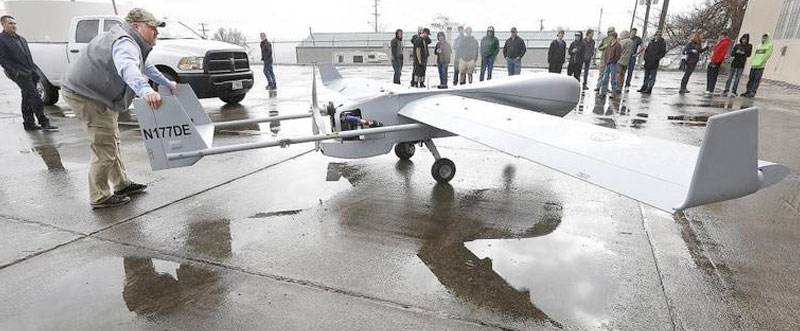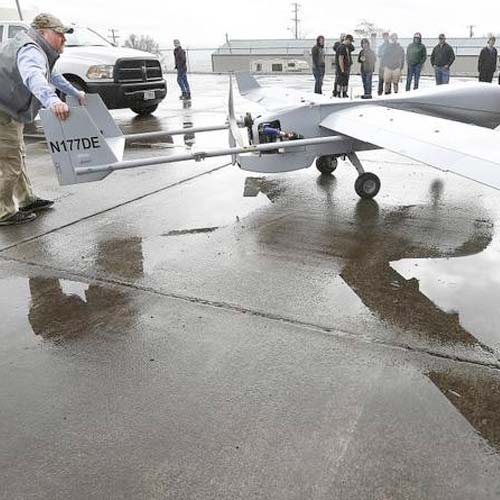
NASC in the News
NASC in the News
Unmanned aircraft flies Mid-Columbia now, Arctic next
Darryl Abling, UAS Range Manager in Pendleton, describes the testing and training taking place at the Oregon airport by an unmanned aerial system that will be used by PNNL scientists in Alaska to collect comprehensive data about atmospheric condit By Bob Brawdy.
The ArcticShark unmanned aerial vehicle circled over the Pendleton airport Wednesday afternoon as the pilot and copilot sat in a control trailer on the ground.
“This is not a drone. A drone is a toy,” said Mike Hubbell, director of flight operations for Pacific Northwest National Laboratory in Richland.
The ArcticShark, a custom-built system with a 22-foot wingspan, will be used to gather atmospheric data in the Arctic to aid in global temperature research.
PNNL took possession of the $800,000 aircraft Sunday.
Through the next week, pilots will train and test it at the Pendleton airport, home to the Pendleton UAS Range, a Federal Aviation Administration test site for unmanned aircraft.
As other craft take off at the airport, the ArcticShark is treated like a manned aircraft and continues flying in controlled airspace.
“I think we are making history here,” said Beat Schmid, manager of the Atmospheric Radiation Measurement Aerial Facility at Pacific Northwest National Laboratory.
The aircraft was built by Navmar Applied Sciences Corp., modeled after the slightly smaller TigerShark that flew military missions in Afghanistan.
Navmar had to adapt it to fly in temperatures as cold as minus 40 degrees, making sure instruments do not seize and fail.
PNNL will conduct engineering test flights initially with the ArcticShark, but will make it available to researchers starting in 2019.
The use of the aircraft, owned by the Department of Energy, will be managed by the Atmospheric Radiation Measurement Climate Research Facility, which is available to scientists worldwide. The facility is run jointly be several DOE labs, including PNNL.
ArcticShark will collect information that can be used in climate models to better predict Earth’s future climate.
“The Arctic is a bellwether of climate change,” Schmid said. “It is where it happens the fastest.”
With warming occurring more quickly than climate models predicted in the Arctic, better data can help improve the models.
Once deployed, the ArcticShark is expected to gather the world’s most sophisticated atmospheric data.
It can detect the size and number of water droplets in clouds and the size and number of aerosols, the tiny particles needed to form a cloud. Temperature, pressure, humidity, wind, solar and infrared radiation and trace gases also will be measured.
It is not necessarily replacing data collection by manned aircraft. The Atmospheric Radiation Measurement Facility at PNNL also has a Gulfstream-1 plane it deploys for climate research.
But there are tasks that the ArcticShark can do better. It could be used to fly low to the ground or for slow flights that allow some data-collection instruments to operate better.
It can be programmed to fly over the same spot again and again, without subjecting an onboard crew to tedious repetition, Schmid said.
“We can take a little more risk in an unmanned aerial vehicle,” Schmid said.
Not that scientists plan to take many risks. The ArcticShark is the centerpiece of a $2.5 million unmanned aerial system program that includes an operation and transportation trailer, training and spare parts.
The ArcticShark was built large enough to carry a satellite system for pilot communication and can also be radio-controlled.
The track it is to fly in the sky, its altitude and other instructions are programmed for each flight, but pilots can change instructions midflight if needed.
“Most of the time it is on autopilot,” Hubbell said. “If everything goes well all I have to do is taxi the aircraft out to the runway and engage autopilot.”
It can carry 100 pounds of scientific instruments packed into the front end of the craft with its satellite system. It uses a rotary engine and a back propeller.
Fully fueled, it can fly for about eight hours. It can fly up to 15,000 feet and has a maximum speed of 75 mph. It was built to be light, with a gross takeoff weight of 625 pounds.
PNNL’s ArcticShark, unmanned aerial system, testing and crew training in Pendleton



